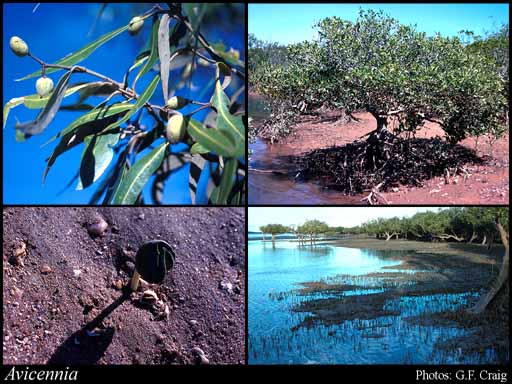- Reference
- Sp.Pl. [Linnaeus] 2:110 (1753)
- Name Status
- Current

Scientific Description
Family Avicenniaceae.
Habit and leaf form. Small mangrove trees and shrubs. Helophytic. Leaves opposite; decussate; leathery; petiolate; simple. Leaf blades entire. Leaves without stipules. Stem anatomy. Secondary thickening anomalous; via concentric cambia. Roots. Aerial roots present.
Reproductive type, pollination. Fertile flowers hermaphrodite. Unisexual flowers absent. Plants hermaphrodite. Plants viviparous.
Inflorescence and flower features. Flowers aggregated in ‘inflorescences’; in cymes, or in umbels, or in panicles, or in spikes, or in heads. The terminal inflorescence unit cymose. Inflorescences terminal and axillary; with involucral bracts. Flowers sessile; uni- bracteate; bi- bracteolate; small to medium-sized; fragrant; more or less regular, or somewhat irregular; cyclic; tetracyclic. Perianth with distinct calyx and corolla; 9(–11); 2 -whorled; anisomerous. Calyx 5; 1 -whorled; gamosepalous; hairy (on outer surface), or glabrous; imbricate. Degree of gamosepaly, maximum length joined/total calyx length about 0.5. Calyx more or less regular, or unequal but not bilabiate (the lobes quincuncial); persistent. Corolla 4(–6); 1 -whorled; gamopetalous; imbricate; regular, or unequal but not bilabiate (variably zygomorphic in A. officinalis and A. integra, differing within individual inflorescences); hairy abaxially; hairy adaxially, or glabrous adaxially; yellow. Androecium 4(–6). Androecial members adnate (inserted basally or in the throat of the corolla); all equal to markedly unequal; free of one another; 1 -whorled. Androecium exclusively of fertile stamens. Stamens 4(–6). Staminal insertion in the throat of the corolla tube. Stamens slightly didynamous, or not didynamous, not tetradynamous; isomerous with the perianth; oppositisepalous; all alternating with the corolla members. Anthers dorsifixed; dehiscing via longitudinal slits; introrse; tetrasporangiate. Gynoecium 2 carpelled. The pistil imperfectly 4 celled, or 2 celled, or 1 celled. Carpels reduced in number relative to the perianth. Gynoecium syncarpous; synstylovarious; superior. Ovary unilocular; 1 locular. Locules partially secondarily divided by ‘false septa’ (with a 4-angular or 4-winged central column). Styles 1. Stigmas 1; 2 - lobed (the pointed arms equal or unequal, often reflexed). Ovules in the single cavity 4; orthotropous to hemianatropous (the curvature arrested early, the ovule remaining almost orthotropous).
Fruit and seed features. Fruit non-fleshy; dehiscent; a capsule. Capsules valvular (bivalved). Fruit 1(–2) seeded. Cotyledons 2; folded (one abaxially, the other adaxially around the plumular axis).
Special features. Mangroves (growing in a very wide range of salinities and intertidal topographic positions). Corolla tube straight.
Geography, cytology, number of species. Native of Australia. Not endemic to Australia. Australian states and territories: Western Australia, South Australia, Northern Territory, Queensland, New South Wales, Victoria, and Australian Capital Territory. Northern Botanical Province, Eremaean Botanical Province, and South-West Botanical Province.
Additional characters Fruit rostrate (often), or erostrate.